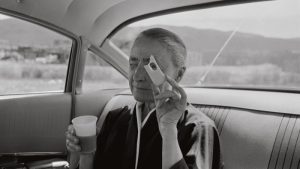Are you sitting on a Ladybird goldmine?
Unlock the Editor’s Digest for free
Roula Khalaf, Editor of the FT, selects her favourite stories in this weekly newsletter.
Look hard enough at any bookshelf in Britain and you’ll probably find a Ladybird book. Rooting around my family home, I find The Postman and the Postal Service, Rumpelstiltskin and How It Works: The Hovercraft – plus some less wholesome titles from a 2015 series of adult spoofs (How It Works: The Husband). Alas, we could only make a few pounds from the collection. For the more fortunate, a single volume could command hundreds.
Collector Helen Day began scouring car boot sales for Ladybird books in 1999, shortly after having a baby. She has now amassed 10,000 titles, but was intrigued by how little was known about the publishers that first produced them. In 2000, she hand-coded a website charting their history (ladybirdflyawayhome.com), and people started contacting her with stories about the company. “It had been completely under-researched,” she says, “so collecting the books turned into collecting the history.”


Helen Day’s copy of High Tide

Bunnikin’s Picnic Party, the first classic Ladybird book
The name Ladybird was trademarked in 1915 by Wills & Hepworth, a Loughborough-based print shop that began producing children’s picture books during quieter moments. But the books only took off in 1940, when wartime paper rationing led the business to experiment with different formats. It was discovered that a single sheet of paper could be carefully folded into a 56-page pocket-sized book, now considered the “classic” Ladybird format. When, in the 1940s, commissioning editor Douglas Keen noticed a demand for children’s non-fiction, Ladybird expanded from publishing nursery rhymes and fairy tales into factual titles. The Key Words Reading Scheme followed siblings Peter and Jane as they baked, biked and bought sweets, all while teaching new vocabulary to young readers. It had sold more than 100 million copies by 2016.
Other titles were slightly less successful. “The rarest books are often the ones that were least popular at the time.” The fictional tale High Tide, a rhyming story about seafaring cats, and The Impatient Horse, an adventure involving an errant milk float, are notoriously sought after: a copy of The Impatient Horse is currently available for £250 from Keswick Bookshop. Then again, popular titles such as 1944’s Cinderella command high figures due to sheer demand. “Cinderella was the only one in this series to be published with a dust-wrapper,” says Maria Goddard, buyer for rare and collectable books specialist Stella & Rose’s Books, which has a first edition priced at £180.



Michael Coughlan’s first edition of Cinderella

The Impatient Horse – sold for £97.99, countryhouselibrary.co.uk
One of Ladybird’s first ventures into original fiction, a series about the exploits of a boy and his koala called The Adventures of Wonk, is similarly collectable. There is one title that Day calls a “Loch Ness monster”, as “nobody knows if it really was published”: a plain-cover version of How It Works: The Computer was said to have been ordered by the Ministry of Defence in order to train its employees. While it’s still missing from Day’s collection, one visitor to her travelling exhibition, The Wonderful World of the Ladybird Artists, confirmed the existence of the elusive edition as her father had commissioned it.
The improvised nature of Ladybird’s publishing operation makes identifying the (often more valuable) early editions a minefield: they were known to completely rewrite and reillustrate books but leave the original publication date on the title page. (If you’ve picked up an old Peter and Jane book and been bewildered to find Jane in a pair of jeans, this would be why. Try again and you’ll find the little white frock you remember.) Some books erroneously state “first edition”.

The Adventures of Wonk, from the collection of Helen Day
Day meticulously catalogues useful clues on her website. Does the Ladybird logo have open wings (dating it to the ’40s or ’50s) or closed wings? If the price isn’t decimalised, it dates the book to pre-1971. “Often, rich pickings are to be found in antiquarian bookshops,” she says, “where the staff don’t know what they’ve got because they’re looking for the wrong things.” eBay, though, is now the most fruitful patch. Farmer Michael Coughlan uses it to source his collection, which he arranges in his pantry in County Waterford, Ireland. He has a first-edition Cinderella, but Bunnikin’s Picnic Party, the first classic Ladybird, still eludes him.
WHERE TO BUY
Books & Ink Bookshop booksandinkbookshop.com
Country House Library countryhouselibrary.co.uk
Loe Books loebooks.co.uk
Stella & Rose’s Books stellabooks.com
WHAT TO READ
Ladybird by Design by Lawrence Zeegen (Penguin, 2015)
WHERE TO SEE
Helen Day’s The Wonderful World of the Ladybird Artists Opening at Peterborough Museum in spring 2025, before travelling to Ushaw Historic House, Durham
The Museum of English Rural Life merl.reading.ac.uk
“Ladybird books brought what had previously been a very black and white world to life; they were an explosion of colour,” says Lawrence Zeegen, professor of illustration at University of the Arts London and author of Ladybird by Design. Ladybird’s illustrators included war artist John Kenney and Royal Academician Charles Tunnicliffe, “the foremost natural history illustrator of the 20th century”, says Tim Loe of natural history specialist Loe Books. Like many artists, Tunnicliffe worked as a commercial illustrator after the 1929 financial crash; it is now these works for which he is best remembered.
The original watercolours from Tunnicliffe’s What to Look For series, seasonal vignettes of gambolling lambs and leaping squirrels, are stored in the Ladybird Books Ltd Archive at the University of Reading, along with 20,000 other artworks. “Not many of the artworks have emerged out in the open market because they were, by contract, owned by Ladybird,” says Zeegen. Cotswolds bookshop Books & Ink sells illustrator Roger Hall’s original gouache paintings for Ladybird’s history book on prison reformer Elizabeth Fry online (from £150).
Ladybird was acquired by Pearson in 1972 and then by Penguin in 1998. For many collectors, interest in the books dwindles after this point. But the ingenious design and high production value of the older numbered series continues to appeal. The collecting community, adds Day, is an internet “oasis” where everybody is unusually polite, or as she puts it, “terribly Ladybird”.
#sitting #Ladybird #goldmine







